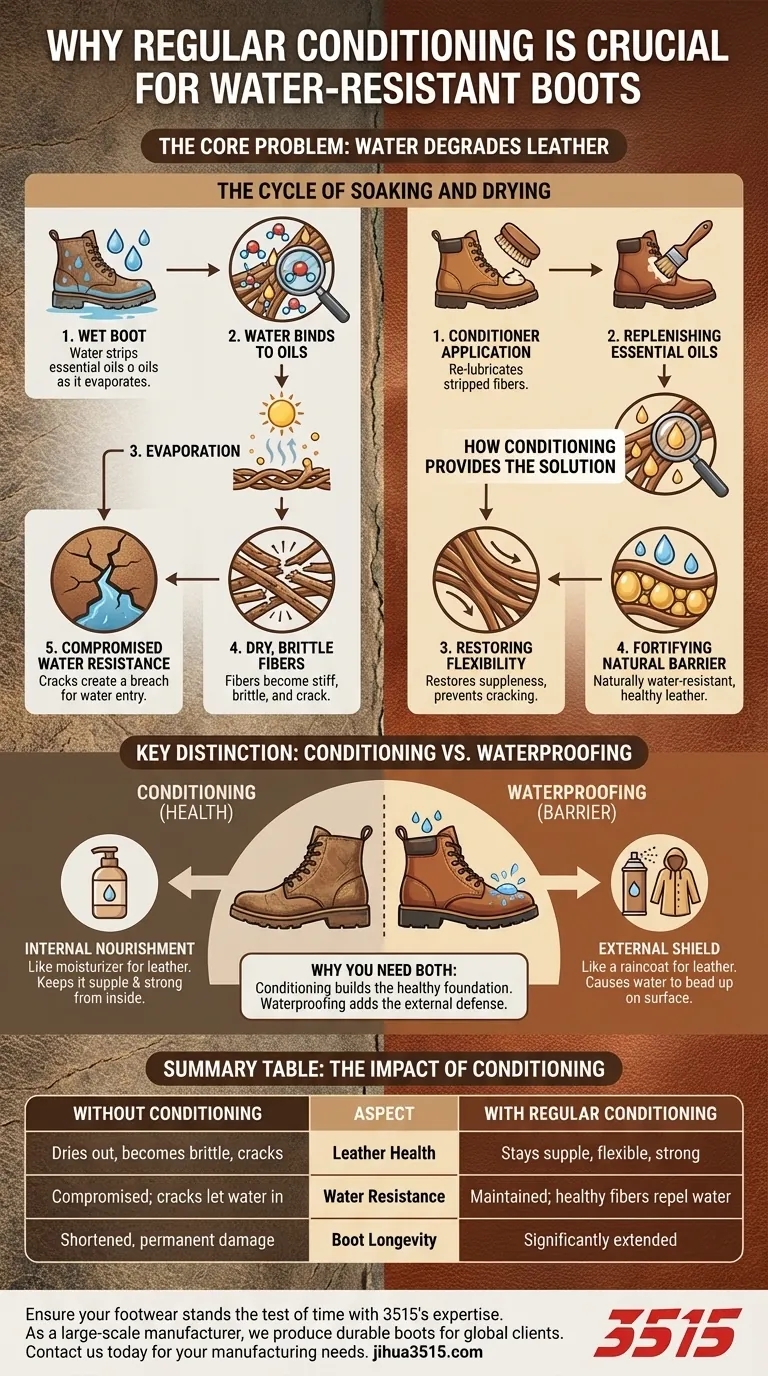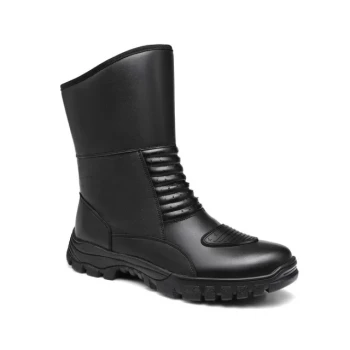To put it simply, regular conditioning is crucial for water-resistant boots because it replaces the essential oils within the leather that water exposure strips away. Without these oils, the leather dries out, becomes brittle, and eventually cracks, which permanently compromises its structure and its ability to repel water.
The core issue isn't the water itself, but what happens when it evaporates. Conditioning acts as a preventative health measure for the leather, maintaining the material's internal flexibility and integrity, which is the true foundation of long-lasting water resistance.

The Core Problem: How Water Degrades Leather
To understand the need for conditioning, you must first understand how water interacts with a natural material like leather. It's a cycle of saturation and dehydration that can slowly destroy your boots.
The Cycle of Soaking and Drying
When your boots get wet, water molecules bind to the natural oils and fats within the leather's fibrous structure. As the boot dries and the water evaporates, it pulls these vital oils out with it.
The Result: Dry, Brittle Fibers
This repeated loss of oils leaves the leather fibers stiff and dry. Instead of flexing and moving as you walk, they begin to grind against each other, leading to microscopic tears.
Compromised Water Resistance
Over time, these tiny tears develop into visible cracks. Each crack is a breach in the boot's defense, creating a direct path for water to penetrate the material and reach your feet.
How Conditioning Provides the Solution
Conditioning directly counteracts the damaging effects of the evaporation cycle. It is not just a surface treatment; it is a fundamental process of nourishing the material from within.
Replenishing Essential Oils
A quality conditioner reintroduces fats and oils back into the leather's structure. This process re-lubricates the fibers that have been stripped by water exposure.
Restoring Flexibility and Suppleness
With their oils replenished, the leather fibers can once again slide against each other smoothly. This restores the boot's flexibility, prevents cracking, and significantly improves comfort.
Fortifying the Natural Barrier
Well-conditioned leather is naturally more water-resistant. Its fibers are plump and saturated with oils, leaving less space for water to soak in and begin the damaging cycle again.
Understanding the Key Distinction: Conditioning vs. Waterproofing
Many people use these terms interchangeably, but they serve two very different functions. Confusing them can lead to improper care and damaged boots.
Conditioning is for Health
Think of conditioning as moisturizer for the leather. Its primary purpose is internal nourishment. It keeps the material supple, strong, and healthy from the inside out.
Waterproofing is for a Barrier
Think of waterproofing products (like waxes or sprays) as a raincoat for the leather. Their primary purpose is to create an external shield that causes water to bead up and roll off the surface.
Why You Need Both
Conditioning creates a healthy, resilient foundation. Applying a waterproofing product over dry, cracked leather is ineffective. For maximum protection, you must first ensure the leather is well-conditioned, then apply a waterproofing agent to add that external layer of defense.
How to Apply This to Your Boots
Your approach to boot care should be guided by your specific goals and the condition of your footwear.
- If your primary focus is longevity and comfort: Prioritize a consistent conditioning schedule to keep the leather supple and prevent the permanent damage caused by cracking.
- If your primary focus is maximum water repellency for harsh conditions: Use a dedicated waterproofing product after you have thoroughly cleaned and conditioned the leather.
- If you work in a consistently dirty or dusty environment: Make cleaning a frequent habit, as grime can wick moisture and oils out of the leather even on dry days.
Ultimately, viewing conditioning as essential maintenance is the key to protecting your investment and ensuring your boots protect you for years to come.
Summary Table:
| Aspect | Without Conditioning | With Regular Conditioning |
|---|---|---|
| Leather Health | Dries out, becomes brittle, cracks | Stays supple, flexible, and strong |
| Water Resistance | Compromised; cracks let water in | Maintained; healthy fibers repel water |
| Boot Longevity | Shortened due to permanent damage | Significantly extended |
| Primary Function | N/A | Internal nourishment of the leather |
Ensure your footwear stands the test of time with 3515's expertise.
As a large-scale manufacturer, we produce a comprehensive range of durable boots for distributors, brand owners, and bulk clients. Our deep understanding of materials like leather ensures the products we create are built to last.
Let us help you provide your customers with high-quality, long-lasting footwear. Contact our team today to discuss your manufacturing needs.
Visual Guide

Related Products
- Premium High-Cut Waterproof Safety Boots Manufacturing & Wholesale Solutions
- Premium Wholesale Waterproof Safety Boots High Performance Protection for Industrial Markets
- Heavy-Duty Waterproof Nubuck Safety Boots Safety Shoes for Bulk Supply
- Durable Leather Tactical Boots Wholesale & Custom Manufacturing for Brands
- Factory Direct Wholesale Rain Boots Durable Waterproof & Fully Customizable
People Also Ask
- What are the characteristics of steel toe boots? Maximum Protection & Key Trade-offs
- What are the pros and cons of steel toe work boots? A Guide to Maximum Protection vs. Comfort
- What is the general recommendation for both steel and composite safety footwear after a significant impact? Replace Immediately for Safety.
- What are the main drawbacks of traditional steel toed safety boots? Heavy Weight & Other Key Disadvantages
- What organization provides safety standards for work boots? Meet ASTM International, the Key to OSHA Compliance



















